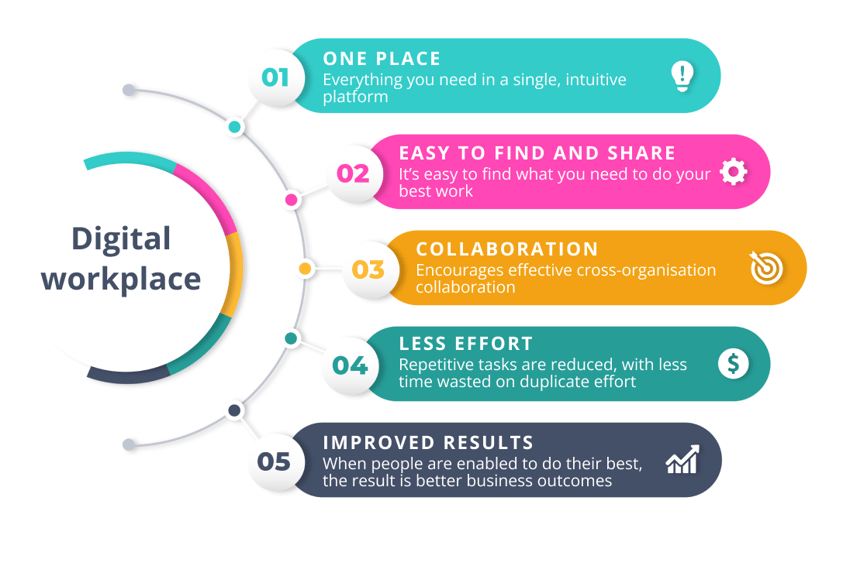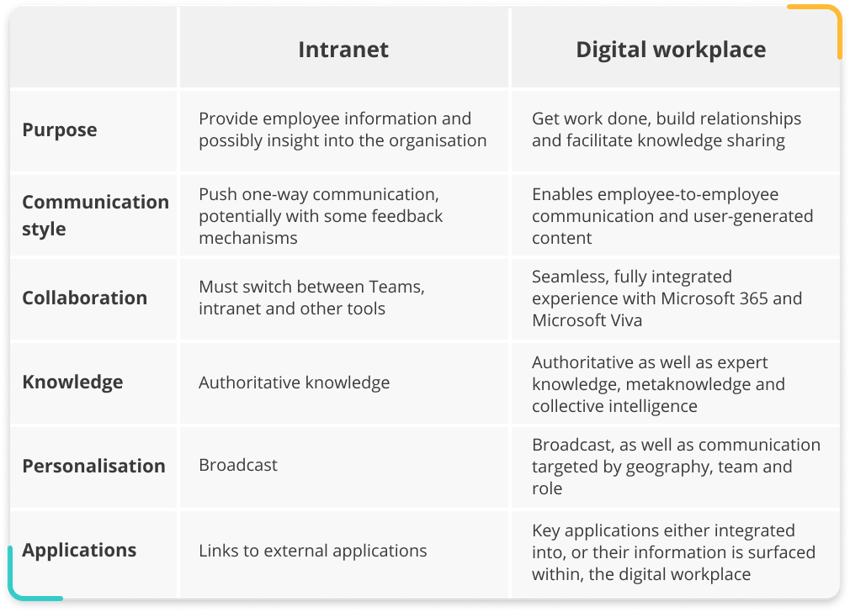What's the difference between intranet and digital workplace solutions? And which is the best solution for your business?
The pandemic forced businesses to invest in technologies that help employees to continue to do their work from anywhere. As a result, many companies have turned to intranet and digital workplace solutions to combat communication breakdowns and to keep the wheels of business turning.
While an intranet and a digital workplace are different, some of the terminology used to describe them is interchangeable. Let's work through what this means.
If you’ve clicked onto this blog then I’m assuming that you are already familiar with the concept of an intranet and you’re wondering how a digital workplace is different. Let’s start with your perception of an intranet. If like me, you started in the working world many years ago you'll remember the archaic intranet: a clunky, outdated dumping ground. If we'd had gifs for tumbleweeds back then, they would have definitely owned a spot on the home page!
Thankfully there have been a lot of advancements within the intranet space since then. Today’s intranets can be used as powerful communication platforms. Modern intranets often host a number of features including: notice boards, data dashboards, social media feeds such as Yammer, and so on.
Let’s start with Microsoft’s definition of a digital workplace:
“The digital workplace encompasses all the technologies people use to get work done in today's workplace… It ranges from your HR applications and core business applications to e-mail, instant messaging and enterprise social media tools and virtual meeting tools.”
Notice here how it states “all technologies people use to get work done”. Think about ‘macro’ and ‘micro’. The digital workplace is the macro environment in which all of your digital tools sit. The intranet is a micro environment that sits within the digital workplace. It may include some of an organization's communication and document storing tools. Check out the digital workplace diagram below:

There can be a lot of confusion around the descriptions of digital workplace solutions and intranets. Similar language gets used to describe both. It is often said that purpose of each platform is to share and store knowledge. They are both often also described as a place where collaboration and communication happens. But there are differences, and the below section aims to set some of these differences apart.
Think of an intranet as a final destination. It’s a place to put finalized content and services that are ready for use and to be showcased to the rest of the organization:
Let’s now apply some of these examples:
The intranet can be a useful place for the marketing team to put their latest and finalized materials. Sales and customer service staff know they can always come to the same place to get the marketing material they need for clients. They trust it’s the latest, up-to-date version and they can quickly find it. This relieves pressure, especially if they are dealing with a customer requiring something urgent on the phone.
Think about all of the important policies and procedures the HR department within your organization has to manage and inform employees on? Having the latest versions on the internet means that managers can onboard new starters more easily. They know where to go to get all of the latest information. This also reduces queries for the HR Team because employees know specifically what they need to do.
You can log helpdesk queries for IT problems, holidays, fill out expense forms etc. By making these processes self-service it relieves the burden of the department that processes these requests. Self-service reduces the number of cumbersome tasks a department may have to deal with. They are also relieved of backlogs due to increased activity of employee demand during peak times. This can reduce departmental costs and/or allow a department to focus resources on other objectives. In an ideal world they could focus more on innovation and creative tasks.
Showcasing company led initiatives on the intranet is a great way to receive feedback. Putting it out there to the whole organization can generate insight and ideas from individuals that may never have had a chance to voice their opinion before - some brilliant ideas may surface.
From the businesses perspective, an intranet can inform and provide insight into what it needs employees to do culturally. It can select the preferred delivery of communication:
By structuring communication in this way employees know clearly what is expected of them.
This can strengthen the company culture. Implementing social elements means staff can get to know each other on a more human level. This is not only helpful for staff working from home and hybrid working but also for geographically-dispersed employees.

Remember earlier how we said that that the digital workplace is where “all technologies people use to get work done” resides and that it’s the macro environment in which the intranet sits? If the intranet is the place where all content and services that are ready to be showcased to the rest of the organization are held, then the digital workplace is the place where all of the content and services within an organization are developed and created. The tools within a digital workplace can be used to:
A digital workplace solution can enable you to centralize all of the knowledge, people and expertise you need for a specific project, case or account in one place. Let’s say you’re working on a specific project, named project Danube (I once worked at an organization that used famous rivers to name each project).
When you visited the project Danube workplace you could see:
Each project member has everything they need to complete their tasks. They can also see where everyone else is at with their tasks. This set up makes collaborating with people to complete tasks a lot easier.
Whatever your role, if you work in a large organization you will collaborate with different individuals, groups and departments to get tasks done. These can include:
When you think about your organization and how many of these different levels of collaboration that are taking place at any one time it can be mind blowing! And it can be so for employees who have to operate on a number of these different levels, on different tasks often simultaneously. This is why having everyone and everything you need to complete a task in one place is so important. A digital workplace solution allows you to cut through these levels and noise and get exactly what you need.
Put simply this is a way of working that doesn’t require everyone working towards a common goal to be working on it at the same time. A digital workplace is the perfect platform to foster this kind of working style. See how to make hybrid working successful for further information.
If business tasks, projects and workflows are carried out within a digital workplace environment, these processes and interactions happening across an organization can be measured. Analytics and data can be harvested and used to justify performance and make business critical decisions. It enables a business to gain deep insights and measure the results of its activities. This data can even be visualized to bring about a deeper understanding of how people are using their digital workplace platform.
You can now see how collaboration and communication both take place within an intranet and a digital workplace solution. They are equally important in both.
I like to think about it like a theatre production. The intranet is the final show to be showcased. It can be both interactive and non-interactive with its audience and the audience sees exactly what the producers and actors want them to see. The digital workplace not only hosts the final show but it’s the place where all the people are working together to create and bring together the final show.

A digital workplace can have all the digital capabilities in the world but if it’s overly complicated the functionality will be lost on the average user. The interface needs to be straightforward enough to be used by everyone, regardless of their level of digital skills.
For any digital workplace solution to look beautiful and be a dream to use, it must organize its content effectively. Content must be easy to find for the user and easy to update and maintain for the owner.
A digital workplace creates a lot of data. In order to function properly and process this data, it needs to be built on an infrastructure that can support the users’ needs and any ongoing maintenance efficiently. You may have heard the term Information Architecture. We won’t go into detail here but put simply, it is the structural design of a digital workplace. It encompasses how the digital workplace organizes and labels the data within it.
Machines are getting clever. The use of Artificial Intelligence (AI) is now being applied to many settings within the digital realm and the digital workplace is no different. Think about the amount of simple, mundane, repetitive tasks you do throughout your day. AI is now being developed to elevate the burden of some of these tasks. Take for example the task of extracting key information from important documents such as legal contracts, invoices, memorandums’ etc. A machine can be programmed to extract specific data from thousands of these sources, within seconds and at a highly accurate rate.
It's never been more important to review your digital experience. The current state of creaking intranets and outdated technology has placed a heavy burden on businesses, and holds them back. There's also a global need to provide engaging digital workplace platform that provide an optimal employee experience, which is becoming critical as recruiting and retaining talent in the new world of work becomes more challenging.
Subscribe to our newsletter
This site is protected by reCAPTCHA and the Google Privacy Policy and Terms of Service apply.

This site is protected by reCAPTCHA and the Google Privacy Policy and Terms of Service apply.